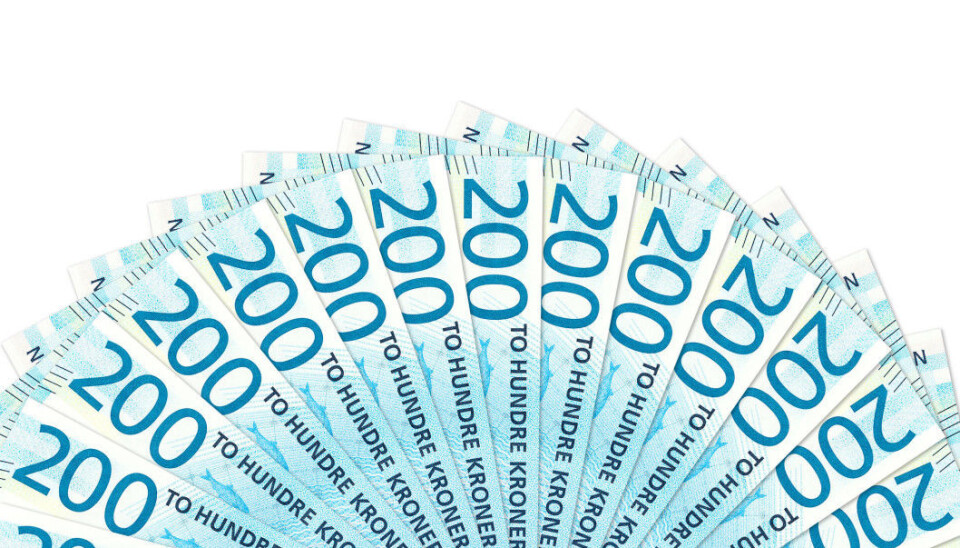
Strong increase in Norwegian pay gap
The difference between those who earn the most and the least in Norway has increased, according to new data from Statistics Norway. This increase is clearly greater in the public sector than the private sector.
Norway might not necessarily be the first country that comes to mind when you think about income inequality.
But new numbers from Statistics Norway, the country's statistics agency, show that income inequality is growing.
People with the highest pay now earn almost 4 times more each month than those who have lowest pay and work 37.5 hours per week, which is the standard work week.
This growing salary gap has climbed faster in Norway than in other OECD countries.
A growing wage gap
The difference between the most well paid and the poorest paid in Norway has grown substantially over the past two decades.
In 1997, the average monthly salary for individuals in the top 10 per cent of salaries was 2.8 times higher than the pay for those in the lowest 10 per cent. By 2017 this multiplier had increased to 3.8.
This corresponds to a pay gap in 2017 of approximately EUR 6,550, according to an analysis by Preben Geier and Knut Håkon Grini at Statistics Norway.
Read More: Four charts which should worry you about rising house prices and inequality
Highest incomes have grown the most
By dividing all Norwegian wage earners into ten groups (deciles) Geier and Grini were able to detect the increase in the salary gap.
The most striking increase is the difference between those who earn the least and those who earn the most.
Rolf Aaberge, a researcher at Statistics Norway, says an important explanation for this difference is an increase in pay to top executives.
In fact, in the top decile, Geier and Grini also found a large difference, by dividing earners into single percentage groups.
For example, people in the 91 per cent group of wage earners earned an average monthly salary of EUR 6,605. Top earners in the 100 per cent group earned a monthly salary is EUR 16,460.
Those who earn at least work in hospitality
The lowest 10 per cent of Norwegian earners includes many people with jobs such as waiters, fast food workers and salespeople.
This group also includes many young people who have only ever had poorly paid jobs and have only worked for a brief period.
Immigration can also partly explain why the bottom step of the salary ladder has failed to keep pace with overall increases in income development, says Aaberge.
"Over the last 10-15 years, many immigrants with low qualifications have come into the Norwegian labour market. If they get a job, these jobs are often poorly paid,” he says.
He also says that immigration may have allowed the persistence of some jobs that would have otherwise been replaced by new technology. If employers can hire workers at low pay for jobs that could otherwise be replaced by technology, they may choose to postpone making the investment and pay workers instead, says Aaberge.
Read More: Gender gap in retirement: Norwegian men retire earlier than women
Gini coefficient illustrates differences
Statisticians and social scientists often use what is called the Gini coefficient to identify pay inequality. This number varies between 0 (low inequality) and 1 (high inequality).
If everyone in Norway had the same salary, the Gini coefficient would be 0. And if all wages were only paid to a single person, the Gini coefficient would be 1.
Public sector shows biggest differences
When SSB researchers looked at wage earners in private and public jobs separately, they find that wage differentials have increased significantly more in state and municipal jobs than in the private sector.
From 2008 to 2017, the Gini coefficient in the public sector has increased by 21.4 per cent.
By comparison, it rose by just 7.7 per cent for the private sector for the same period.
This clearly shows that the pay gap between lowest and highest paid state and municipal jobs has increased more than in the private sector.
Aaberge says that increases in executive pay in the public sector are an important reason for this trend.
Read More: How does an increasing pay gap affect our attitudes?
Growth in inequality highest in Norway
From 2000 to 2015, inequality in Norway grew more than in most other countries, according to comparisons made by the OECD.
The OECD measures pay differentials slightly differently than Statistics Norway. However, despite its increase in pay inequality, Norway is only ranked number 24 out of the 25 countries involved in the OECD ranking, meaning that the actual differences in pay are relatively low in Norway compared to other countries.
----------------
Read more in the Norwegian version of this article at forskning.no



































